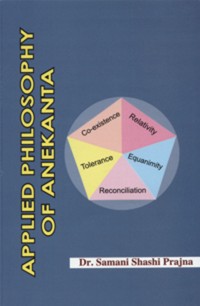Now, it is proper to compare the different kinds of naya as propounded by Lord Mahāvīra. The seven Naya-s are nothing but the extention of two naya-s, dravyārthika naya and paryāyārthika naya.[1] Basically to deal with the metaphysical problems, these two perspectives are important. The former is related to the persistent part or identity of a substance technically known as dravya, while the latter deals with the different forms and attributes of the substance technically known as paryaya. Dravya is shown to be permanent from dravyārthika naya and changing from paryāyārthika naya. Of the seven naya-s the naigama, saṅgraha, vyavahāra, fall under the category of substantial view point. The remaining four rjusūtra, śabda, samabhirūḍha, and evambhūta view points constitute the category of modal view point.
In Pañcāstikāyasaṃgraha Kundkunda defines and discriminates two naya-s thus:
evaṃ sado viṇāso asado jīvassa ṇatthi uppādo.
tāvadio jīvāṇaṃ devo maṇuso ti gadiṇāmo.[2]
The dravyārthika principle holds that there is neither birth nor death of the jīva as it has an indestructible essence, which cannot be extirpated even by Time. Jīva is subject to origin and decay only from the point of view of paryāyārthika naya. Although soul experiences both birth and death, but still it is neither really destroyed nor created. Origin and decay refer respectively to the disappearing deva state or the appearing human state and these are only its paryāyas or modes.
Another category of naya-s as found in agama-s are niścaya naya and vyavahāra naya. To deal with the religious truth, these two perspectives are important. The former is related to the subtle or transcendental aspect of the truth, while the latter, to the empirical or conventional one. Ācārya Kundakunda has explained the omniscience, on the basis of nayas (viewpoints) through the verse of Niyamsāra as follows:
jāṇadi passadi savvaṃ vavahāraṇaeṇa kevali bhagavaṃ.
kevalṇāṇī jāṇa passdi ṇiyameṇa appāṇaṃ.[3]
According to the empirical viewpoint (vyavahāra naya), the kevalī (omniscient) knows everything, but according to the transcendental viewpoint (niścaya naya), the kevalī knows himself alone. The implication is that, the kevalī is omniscient from the practical viewpoint (vyavahāra naya) and the knower of himself alone, from the transcendental viewpoint (niścaya naya). Needless to state, Jinabhadra has enriched the Jain philosophy by his profound scholarship. Jinabhadra gives an appropriate example of a bhramara (black bee) to show the essential difference between vyavahāra and niścayanaya in Viśeṣāvaśyakabhāṣya:
logavvavahāraparo vvavahāro bhaṇai kālao bhamaro.
paramatthaparo maṇṇai nicchaio pancavaṇṇo tti.[4]
The bhramara (black bee), as seen from vyavahāra naya, is nothing but black in colour, while the same insect, when seen from niścyaya, contains all the five colours. In other words, vyavahāra, unlike niścaya, does not state ultimate truth. On the contrary, vyavahāra follow the view upheld by some one naya and it does not take into account, as niścaya does, the views upheld by all the nayas.
Again seven naya-s are further classified under two heads as artha naya and śabda naya. Specially to deal with the problem of communication, these two perspectives are applied. The former is related to the meaning or senses of a sentence, while the latter, to the words used by a speaker or knower.[5]
A naya has a double function i.e., experience of the object and its verbal expression.The classification of the first four view points, which are mainly concerned with the ontological aspect of a thing are called the artha naya.The remaining three śabda naya,being mainly concerned with the linguistic aspect on account of being expressed in verbal proposition.[6]
 Dr. Samani Shashi Pragya
Dr. Samani Shashi Pragya

